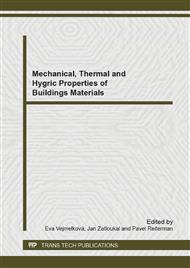p.114
p.119
p.125
p.130
p.136
p.141
p.145
p.149
p.154
Destructive and Non-Destructive Testing of High Temperature Influence on Refractory Fiber Composite
Abstract:
The main aim of this contribution lies in the description of mechanical properties fiber cement composites after exposure to high temperatures. Destructive and non-destructive methods were used to investigate the influence of heat loading. The effect of refractory binder compared to common Portland cement binder was observed. Widespread non-destructive testing method can describe the changes of mechanical properties due to influence of external load e.g. high temperature at the level of 1000 °C. The tensile strength and compressive strength were investigated on specimens 40 x 40 x 160 mm. Before these destructive tests dynamic modulus of elasticity and tentative compressive strength were provided.
Info:
Periodical:
Pages:
145-148
Citation:
Online since:
July 2014
Authors:
Price:
Сopyright:
© 2014 Trans Tech Publications Ltd. All Rights Reserved
Share:
Citation:


